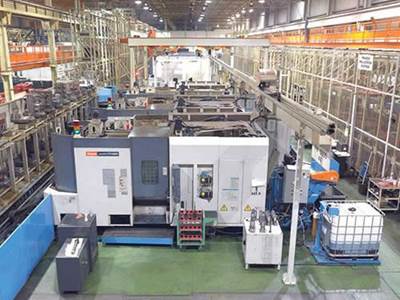Big Screens—Big Results
This machine tool builder is getting the most from its machine monitoring system. Making data about machine utilization very visible is helping operators make better decisions about shopfloor activities.
At its Florence, Kentucky, manufacturing plant, machine tool builder Mazak has been aggressively implementing its iSMART Factory concept, a production strategy based on the concepts and goals of data-driven manufacturing. The foundation for this project is an MTConnect-enabled machine monitoring system.
I spoke to Ben Schawe, VP of manufacturing; Mark Wiesman, fabrication manager; and Rocky Rowland, FMF assistant manager, about some of the main lessons learned during this implementation, which has been underway for about three years. This is a summary of their remarks:
1. Building an appropriate data infrastructure is the first step. Mr. Schawe explained that the core of this infrastructure is a network of fiber optic cables with line drops at selected locations. This network facilitated the installation of 60-inch display screens throughout the manufacturing areas to show the data collected and analyzed by the machine monitoring system.
2. Use a pilot project to ease the learning curve and get everyone on board. The first display screens were installed in late 2013 to connect 15 machining centers to the system, which uses the MTConnect interoperability standard to interface with the disparate CNCs on these machines. Supervisors and operators were involved in evaluating the machine monitoring software, encouraged to provide input and given a clear understanding of the direction that this data-driven manufacturing initiative was taking.
With the successful completion of this pilot project, the monitoring system has now been expanded to include six display screens and 55 machines that are actively being monitored.
3. At first, visual awareness creates quick (and significant) results. Mr. Rowland reported that just by showing operators a report of machine utilization, their thinking and practices became more focused on improvements that boosted uptime. “Simply by seeing what’s going on, they started making better decisions about the way they prepared cutting tools, managed the use of program stops and attended to routine maintenance items,” he said. The result was a 6 to 15 percent increase in utilization per machine.
4. Be sure that data translates into actionable information that helps the operators. One example mentioned by Mr. Wiesman involved his fabrication line. A review of utilization of the laser cutting cells indicated what appeared to be an excessive number of interruptions to running them in the automated mode. Checking with the operators revealed that “optional” (emergency or expedited) parts were being processed on these cells because cutting was much faster than on the hand-loaded laser machines. In fact, this approach was yielding no gain in overall output. Restricting these optional parts to off-line processing restored 12 to 13 percent productivity to the automated cells.
Going forward, Mazak plans to expand its drive to base decisions on data. One new phase requires direct operator input. Mr. Schawe said that the goal is to enable operators to enter data quickly and easily. “Touchpads will be installed where operators can simply walk up, tap the data field they want to enter, and then pick a few choices. To enter, let’s say, reasons for a pause in machining, the options will be short and straightforward: waiting on tooling, adjusting fixtures, replenishing coolant, indexing inserts and so on,” he said.
The plant also plans to install sensors so that the operating parameters of additional manufacturing systems can be monitored. The perfect example of this will be the newly completed powder coating line for machine enclosure components. Mr. Weisman explained that the new sensors will detect line speed, temperature and pH of wash baths, drying oven temperature, powder levels, and other measurements. All readings will be displayed on one screen for at-a-glance viewing. “Any trend that needs adjustment will be visible, giving operators time to respond well before a condition becomes critical,” Mr. Wiesman said.
Related Content
Shop Quotes Smarter, Works Harder with Machine Monitoring
Temco first installed MT-LINKi to optimize quoting. Now, the software helps the shop optimize its machines — and machine purchases.
Read MoreReinventing a Precision Shop With a Data-Driven Mindset
When this machine shop lost 90% of its business within three months, a reinvention was in order. Here's how it survived after quickly falling on hard times.
Read MoreGive Job Shop Digitalization a Customer Focus
Implementing the integrated digital technologies and automation that enhance the customer's experience should be a priority for job shops and contract manufacturers.
Read MoreCan Connecting ERP to Machine Tool Monitoring Address the Workforce Challenge?
It can if RFID tags are added. Here is how this startup sees a local Internet of Things aiding CNC machine shops.
Read MoreRead Next
Data-Driven Manufacturing Moves Ahead at Mazak
“We thought we knew what our utilization was, but now we know for sure.
Read MoreThe Cut Scene: The Finer Details of Large-Format Machining
Small details and features can have an outsized impact on large parts, such as Barbco’s collapsible utility drill head.
Read More







.png;maxWidth=300;quality=90)



.png;maxWidth=300;quality=90)











